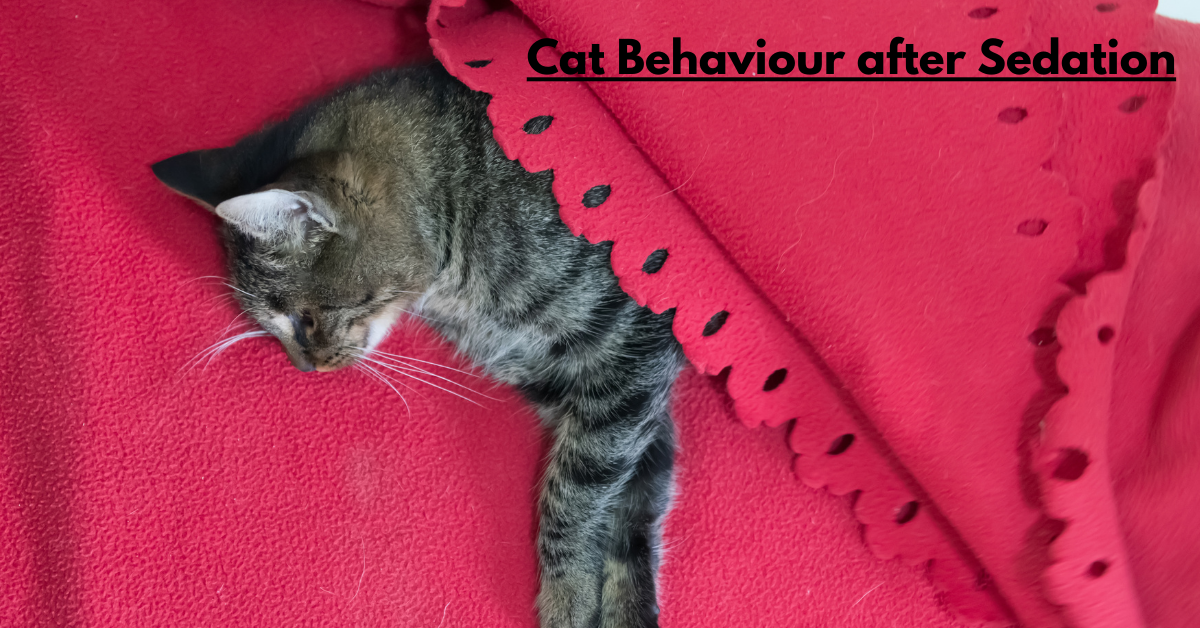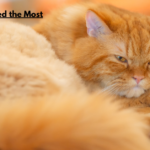Cat Behaviour after Sedation: Calming a cat may be a vital in any case exasperating encounter, both for the cat and its proprietor. Whether it is for a veterinary strategy, travel, or any other reason, understanding what to anticipate with respect to your cat’s behaviour put up-sedation is basic for his or her properly-being and your peace of considerations. These manual objectives to offer a point by point discernment into cat conduct after sedation, tending to common stresses and giving steerage on how to guarantee your tom cat buddy recoups without difficulty.
Key takeaways
- Drowsiness and Disorientation: After sedation, cats frequently appear drowsy and disoriented. They might also have problem on foot or standing, and their actions may be uncoordinated.
- Reduced Appetite and Thirst: It’s not unusual for cats to reveal a reduced interest in meals and water straight away following sedation. Appetite typically returns within 24 hours.
- Temporary Changes in Personality: Some cats may also seem greater affectionate or, conversely, greater aloof than common. These adjustments are generally brief and ought to solve because the sedation wears off.
- Increased Sensitivity to Stimuli: Sedated cats may be extra touchy to mild, sound, and contact. Keeping them in a quiet, dimly lit room can help lessen pressure.
- Grogginess and Sleeping:Cats might also sleep extra than common after being sedated. This is a regular reaction as their body recovers.
- Vomiting and Nausea: Some cats may also experience mild gastrointestinal disenchanted, together with vomiting or nausea, after sedation.
What Happens to Cats After Sedation?
After sedation, the impacts on cats can shift depending on the sort of narcotic utilised, the measurement, the person cat’s well being, and how the sedation was managed. Here’s a point by point clarification of what regularly happens to cats after sedation:
- Initial Impacts: Instantly after sedation, cats may get to be lazy or languid. This is a ordinary reaction as narcotics are planned to initiate unwinding and diminish uneasiness. Cats may show up confused or shaky on their feet initially.
- Duration of Sedation:The term of sedation shifts depending on the sort of narcotic utilised. A few tranquillisers wear off generally rapidly, whereas others may have a longer-lasting impact. Your veterinarian will give direction on how long your cat is likely to stay sedated.
- Recovery Period:As the narcotic wears off, cats ordinarily start to recapture mindfulness and coordination. Amid this recuperation period, it’s critical to give a calm and secure environment for your cat to rest. Maintain a strategic distance from boisterous clamours and unsettling influences to offer assistance encourage a smooth move out of sedation.
- Behavioural Changes:Cats may display brief changes in conduct after sedation. They might be more stifled or dormant than regular. A few cats may involvement mellow queasiness or confusion amid the recuperation phase.
- Monitoring:Veterinarians more often than not screen cats closely amid and after sedation to guarantee there are no antagonistic responses or complications. Imperative signs such as heart rate, respiratory rate, and body temperature may be checked until the cat has completely recovered.
- Potential Side Impacts:Whereas uncommon, a few cats may encounter side impacts from tranquillisers such as unfavourably susceptible responses, intemperate sedation, or respiratory sadness. These side impacts are more likely if the cat has fundamental well being issues or if the narcotic dose is not appropriate.
- Post-Sedation Care:After sedation, it’s vital to take after any particular informational given by your veterinarian. This may incorporate confinements on nourishment and water admissions until the cat has completely recouped, as well as observing for any signs of complications such as delayed dormancy or trouble breathing.
When a cat is calmed, whether thru restorative sedate or anaesthesia, it experiences a period of diminished cognisance and balanced physiological capabilities. The length and escalated of sedation can run depending on the sort and measurement of narcotics utilised, as well as man or lady cat components counting age, well being notoriety, and temperament.
Recovery Period
After the sedation wears off, cats ordinarily begin to recapture cognisance steadily. Amid this time, you can be mindful practices comprising of grogginess, confusion, and shaky development. It’s basic to make a calm and calm environment to your cat to get way better in, detached from boisterous clamours and disturbances.
Physical Effects
Physically, cats can moreover delight in remaining results together with diminished coordination, slower reflexes, and temporal alterations in muscle tone. These impacts can final for a few hours to an evening, depending on the narcotic utilised. It’s crucial to offer a secure space for your cat wherein they may not harm themselves since of disabled engine abilities.
Behavioural Changes
Cat conduct after sedation can run broadly. A few cats may show up additional stifled or lazy than standard, indeed as others might be more focused or vocal. Changes in encourage for nourishment, thirst, and clutter box propensities moreover are not bizarre. These practices for the most part standardise as the narcotic totally clears from the cat’s machine.
Table for Cat Behaviour after Sedation
| Behaviour | Before Sedation | During Sedation | After Sedation |
|---|---|---|---|
| Activity Level | Normal, alert, and active | Reduced, may be drowsy | Drowsy, sluggish, gradually returning to normal |
| Response to Stimuli | Normal response to sounds and movements | Decreased or no response | Slow or delayed response, gradually improving |
| Coordination | Normal, coordinated | Loss of coordination, unsteady movements | Wobbly, unsteady, regaining balance over time |
| Appetite | Normal eating and drinking habits | Decreased or no interest in food/water | Reduced appetite initially, normalising within hours |
| Grooming | Normal grooming behaviour | Minimal or no grooming | Minimal grooming, gradually returning to normal |
| Vocalisation | Normal mewing and purring | Reduced or no vocalisation | Quiet, occasional vocalisation as they recover |
| Breathing | Normal, steady | Slow, steady | Steady, gradually returning to normal rate |
| Body Temperature | Normal | May be slightly lower | Gradually returning to normal temperature |
| Urination/Defecation | Normal | Decreased frequency | May be initially reduced, normalising within hours |
| Behaviour Toward Humans | Normal interaction, friendly or shy | May not respond to human interaction | Initially indifferent or less responsive, returning to normal gradually |
Factors Influencing Cat Conduct Post-Sedation
Several components affect how a cat responds after being sedated:
1. Sort of Sedative
Different narcotics have changing results on cats. A few may furthermore cause more profound sedation or longer recuperating occasions than others.
2. Person Cat Variability
Each cat responds extraordinarily to sedation based completely on components like age, wellness status, and past reports with sedatives.
3. Reason of Sedation
The cause for calming the cat (e.g., veterinary strategy, travel) can have an impact on how the cat carries on a while later. Cats calmed for restorative forms might moreover take longer to get superior since of the nature of the narcotic used.
Common Post-Sedation Practices in Cats
Understanding what practices to check on after sedation permit you to offer higher take care of your cat:
1. Dormancy and Sleepiness
Many cats will be languid or less dynamic than regular after sedation. This is ordinary as the narcotic slowly wears off.
2. Disorientation
Cats may show up confounded or confused promptly after waking up from sedation. They may meander capriciously or vocalise more than usual.
3. Changes in Craving and Thirst
Some cats may have a diminished craving or thirst at first. It’s vital to screen their admissions and empower them to drink water to remain hydrated.
4. Expanded Anxiety or Vocalisation
On the other hand, a few cats may end up more eager or vocal after sedation. This can be a sign of distress or disorientation.
5. Changed Litter Box Habits
Temporary changes in litter box propensities, such as hesitance to utilise it or mischance’s exterior the box, can happen. This more often than not settles once the narcotic impacts wear off completely.
Tips for making a difference Your Cat Recuperate Comfortably
To encourage a smooth recuperation for your cat after sedation, consider the taking after tips:
1. Give Calm and Secure Environment
Create a calm space for your cat to recuperate, absent from clamour and other pets. Guarantee there are no risks that seem lead to damage due to impeded coordination.
2. Screen Nourishment and Water Intake
Offer little sums of their top choice nourishment and energise them to drink water. Screen their admissions closely to guarantee they are eating and drinking adequately.
3. Be Quiet and Reassuring
Give your cat time to recoup at their possess pace. Give delicate consolation and maintain a strategic distance from overpowering them with consideration if they appear disoriented.
4. Take after Veterinary Instructions
If your cat was quieted for a veterinary method, take after any post-operative care informational given by your veterinarian. This may incorporate medicines or particular observing guidelines.
5. Observe for Signs of Complications
While uncommon, complications from sedation can happen. Observe for signs such as trouble breathing, intemperate dormancy, or delayed confusion, and contact your veterinarian if you have any concerns.
FAQs About Cat Behaviour after Sedation
Q: How long does it take for a cat to get over sedation?
Recuperation time can shift depending on the sort of narcotic utilised and man or lady cat variables. Most cats recoup interior a few hours to a day.
Q: Ought to I be stressed if my cat remains languid after sedation?
Mellow grogginess or languor is standard after sedation. If it continues for an amplified term or is watched through diverse concerning signs and side effects, touch your veterinarian.
Q: Can sedation have an impact on my cat’s behaviour long-term?
In most extreme occurrences, sedation has quick-term results that illuminate as before long as the drugs wears off totally. Long-term behavioural alterations are rare.
Q: How can I help my cat feel more comfortable after sedation?
Give a calm environment, screen their nourishment and water admissions, and give tender consolation to offer assistance your cat sense relentless in the course of recuperation.
Conclusion
Understanding and planning on your cat’s conduct after sedation is crucial for his or her properly-being and your peace of considerations. With legitimate care and consideration, your cat will in all probability get way better to their customary self right absent after show handle sedation.
In conclusion, exploring cat behaviour after sedation incorporates remaining control, perception, and proactive care to help your cat by means of this transitory area of changed mindfulness and physical reclamation. By remaining learned and mindful, you may help your cat recoup with no inconvenience and return to their ordinary schedules hurriedly.










